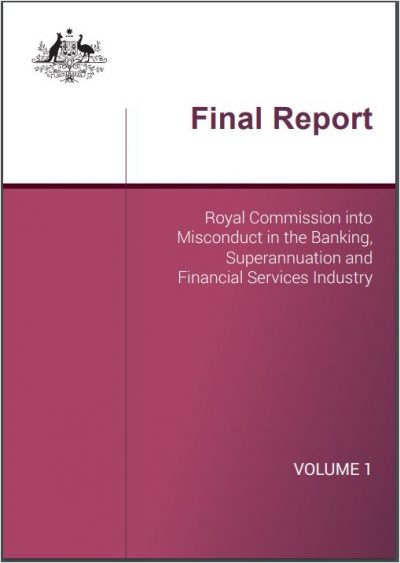
What does the Financial Services Royal Commission mean for insurers?
Mathew Ayoub outlines the potential impacts of the Financial Services Royal Commission Final Report across the insurance value chain, with insights gleaned from Chief Risk Officers and Chief Actuaries.
 Commissioner Hayne’s Final Report on the Royal Commission into Misconduct in the Banking, Superannuation and Financial Services Industry (“Final Report”) was released on 4th February 2019. This article explores its potential impacts across the insurance value chain, and provides an insurance industry perspective on conduct risk management through insights gleaned from Chief Risk Officers and Chief Actuaries in Australian Insurers via a Deloitte survey conducted in September 2018.
Commissioner Hayne’s Final Report on the Royal Commission into Misconduct in the Banking, Superannuation and Financial Services Industry (“Final Report”) was released on 4th February 2019. This article explores its potential impacts across the insurance value chain, and provides an insurance industry perspective on conduct risk management through insights gleaned from Chief Risk Officers and Chief Actuaries in Australian Insurers via a Deloitte survey conducted in September 2018.
Drivers of conduct risk
What is conduct risk, and what is risk culture? What do they really mean?
Good conduct is when an organisation’s behaviours and practices deliver fair and suitable outcomes for customers, employees, suppliers and markets. Conduct risk is the risk of misconduct. It shapes the external view of a company i.e. how are we, or our representatives impacting others, and what do those others think of us? The combination of customer vulnerability, and misalignment between social expectations and insurer practices is what drives conduct risk.

Risk culture is about the ‘way things are done around here’ and how that impacts risk management in the organisation. Risk culture is a system of values and behaviours, present throughout an organisation, that shape day-to-day risk decisions. Attitudes shape behaviour, which forms culture, and this shapes the internal view of a company, which has external impacts manifested as misconduct.
APRA’s landmark report on CBA focussed on three key levers that are instrumental to conduct risk outcomes, these being governance, remuneration and risk culture. Commissioner Hayne’s recommendations cover the governance and remuneration aspects, as well as shifting the balance of power toward the consumer. The recommendations do not cover risk culture in any detail, which in my opinion is because it is difficult to regulate on risk culture. Nevertheless, Commissioner Hayne’s recommendations should not be treated as a comprehensive check-list, particularly given insurers tend to be judged by the 1% of what goes wrong, not the 99% of what goes right. The recommendations provide a useful roadmap for managing today’s community expectations, and there is a lot that can be done to future-proof insurers.
Impacts across the insurance value chain
Balance of Power
Hayne’s recommendations aim to shift the balance of power toward the consumer, for example, by applying the unfair contracts terms rules, which currently apply to many other contracts, to insurance contracts; and amending the avoidance provisions related to non-disclosure and misrepresentations. These have significant implications for product, pricing and claims in particular.
Applying the unfair contract terms to insurance contracts may be much more significant than is commonly understood, because the definition of “unfair” is unclear. For example, consider a claim on a building insurance policy being sold in Townsville that does not include flood coverage. Is it fair that a customer is sold an insurance policy without flood cover, when the risk of flood damage is well known? Would unfair contract terms allow these customers to make a claim?
There is the potential for many other terms within a retail general insurance policy to be held to be unfair. This will create short to medium-term uncertainty for underwriters, as various exclusions and limits are tested for (un)fairness, and in the long run may force premiums to increase as coverage may expand.
Life insurance medical definitions are also an obvious area of contention.
Will insurers limit exposure to, or even exit some markets? And will there be worse affordability, leading to more under-insurance? The answers to these questions have significant implications for insurers, customers and the government.
Amending the existing duty of disclosure puts more of the onus of proof onto the insurer by changing the anti-avoidance provision to show that the insurer would not have entered into the contract on any terms where there was non-disclosure. To deal with this, insurers may choose to apply a loading to such a contract or not offer a contract at all. Adopting this recommendation will unwind a 2013 reform, for which the industry had long lobbied.
Other product related impacts:
- Bringing funeral expense policies under the AFSL regime and ASIC Act.
- Capping commissions for vehicle dealers.
- Ending grandfathered commissions, and an ASIC review of commissions for life insurance, general insurance and consumer credit insurance, with downward pressure on those amounts to zero.
Other distribution and selling impacts include:
- A clearer prohibition on hawking insurance products, removing unhelpful exceptions.
- Introducing a deferred sales model for all add-on insurance.
- A range of recommendations related to financial advice that will impact disclosure around adviser independence, changes to the annual renewal process, and increased reporting and compliance obligations on advisers and licensees.
Insurers will need to reconsider their product design, underwriting rules and distribution strategy, as well as the flow on impact to pricing. They will need to review all documentation and disclosures including application forms, Product Disclosure Statements, and claims forms. This change could be challenging, and will need to be considered in the context of the upcoming product design and distribution obligations (DDO), and the industry Codes of Practice becoming enforceable by 30 June 2021.
Most CROs and Chief Actuaries are of the view that ‘volume of change’ will be hardest to manage in the short term and their organisation’s ‘agility to change’ is a concern. While actuaries have the ability to influence all components of the insurance value chain, specific areas actuaries can add value include building out better conduct metrics and analytics to monitor early warning signs, and automating risk controls particularly for product and incident management to create more efficient and consistent decision-making.
Remuneration and Regulation
There are clear precedents from the banks that insurers will need to follow in addition to the insurance industry specific recommendations. The Final Report states ‘some changes should be made to bring the regulation of insurance into line with that of other financial products’.
The need to bring claims handling under the AFSL regime as a financial service, and under ASIC’s direct scrutiny, has been foreshadowed for some time, including by ASIC. Providers will have to meet AFSL requirements and provide claims handling efficiently, honestly, and fairly. There is potential for increased licensing requirements for claims handling providers, assessors, medical providers, investigators, and others in the supply chain. Consumers will have access to the consumer protection provisions contained in the Corporations Act and ASIC Act.
Insurers will need to understand and potentially implement the Banking Executive Accountability Regime (BEAR), which increases the accountability on executives, through impacts to their remuneration, to drive fair and suitable outcomes for customers/members. On this note, Hayne’s recommendation applies to all APRA-regulated institutions, which includes health insurers, although this is not yet certain as health insurers were not part of Hayne’s mandate. However, given APRA itself has already committed to implementing the BEAR regime within APRA in 2019, and APRA’s tendency to harmonise prudential regulation cross-industry, it is likely health insurers will also need to implement BEAR along with other changes.
While the APRA and ASIC twin peaks model is retained under Hayne’s recommendations, ASIC has been empowered with the role of Chief Conduct Regulator, and both are being empowered to increase their supervisory intensity and enforcement including to pursue criminal charges for some institutions. APRA is expected to publish a report shortly after the end of March 2019 outlining its process around taking enforcement action among other items.
Hayne stated that “Having a wrongdoer compensate those harmed is one thing; holding wrongdoers to account is another,” stating that infringement notices are rarely an appropriate enforcement tool.
CPD: Actuaries Institute Members can claim two CPD points for every hour of reading articles on Actuaries Digital.






